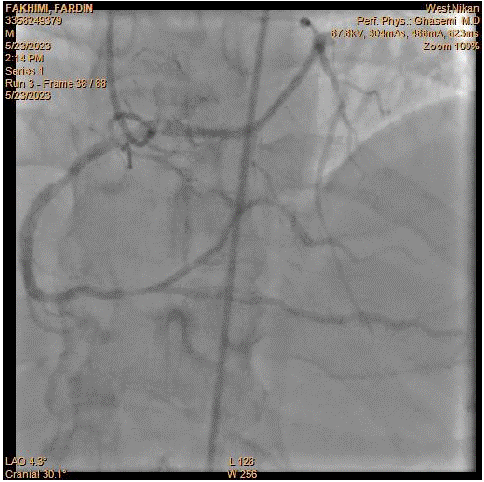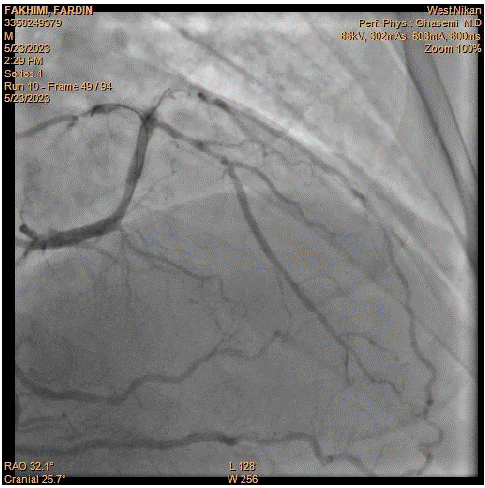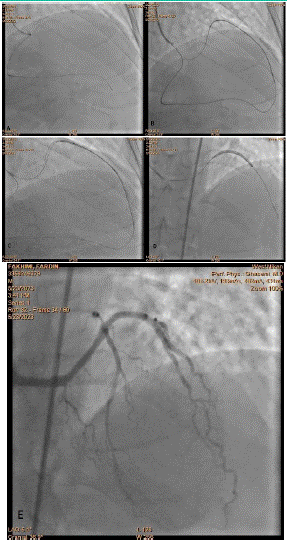
Case Report
Austin Cardio & Cardiovasc Case Rep. 2023; 8(3): 1063.
Angiographic Coronary Revascularization in Patient with Chronic Total Occlusion of Left Coronary Artery Originating from Right Coronary Cusp: A Retrograde Approach
Ghasemi M¹; Tootoonchian MJ²; Harati H³; Laleh Far V4*
1President of Iranian Society of Atherosclerosis, Tehran, Iran
2General Cardiologist, Department of Cardiology, Imam Sadegh Hospital, Arak University of medical Sciences, Tehran, Iran
3Fellowship of Echocardiography, Bahman General Hospital, Tehran, Iran
4Department of cardiology, Pars Hospital, Tehran, Iran
*Corresponding author: Laleh far V Department of Cardiology, Pars Hospital, Keshavarz Boulevard, number 67, PO Box: 1415944911, Tehran, Iran Tel: +989125878713; Fax: + 98 21 88966052 Email: lalleh_2005@yahoo.com
Received: September 25, 2023 Accepted: October 18, 2023 Published: October 25, 2023
Abstract
A 51-years-old man with left main coronary artery originating from right Valsalva sinus presented with unstable angina and multi-vessel coronary disease and chronic total occlusion of anterior descending artery. Percutaneous coronary intervention using retrograde approach achieved complete revascularization and symptom relief.
Keywords: Anomalous left main coronary artery; Chronic total Ooclusion; Percutaneous coronary intervention
Abbreviations: LMCA: Left Main Coronary Artery; CTO: Chronic Total Occlusion; LAD: Left Anterior Descending Artery; PCI: Percutaneous Coronary Intervention; LV: Left Ventricle; RCA: Right Coronary Artery; SCD: Sudden Cardiac Death
Case Presentation
Anomalous Left Main Coronary Artery (LMCA) originating from right coronary cusp is a rare but critical congenital anomaly with possibility of Sudden Cardiac Death (SCD) [1]. Coronary artery Chronic Total Occlusion (CTO) is one of the most challenging condition that cardiologist accost during Percutaneous Coronary Intervention (PCI) [2]. Hence, coronary artery revascularization in the setting of coronary anomaly and CTO is more challenging. The general approach for recanalization of CTO is antegrade approach, but these years, retrograde technique is used more frequently and can ameliorate the outcome [3].
We render a case where PCI has been done perfectly in presence of CTO of Left Anterior Descending artery (LAD) and originating LMCA from right coronary cusp by retrograde approach from Right coronary artery (RCA).
We report a 51 years-old man, a known case of hypertension, was admitted to our clinic with complaints of retrosternal chest pain ( Canadian Cardiovascular Society class III) persisting for one week, which has recently worsened. His symptoms were associated with fatigue and diaphoresis. Upon diagnosis of unstable angina, he was admitted to another center and received treatment with loading doses of Asprin , Clopidogrel , Rosuvastatin and Bisoprolol . Coronary angiography revealed multi-vessel coronary artery disease, with the LMCA arising from right Valsalva sinus and CTO of the mid part of LAD with Rentrop grade-3 retrograde filling from right system (Figure 1). As a result of these findings, he became a candidate for coronary artery bypass surgery. During our visit, his vital signs were stable, and physical examinations were unremarkable. Complete blood count, serum creatinine and cardiac troponin I levels were Normal. Electrocardiogram showed Normal sinus rhythm with no significant ST-segment and T wave deviation. Echocardiography demonstrated preserved Left Ventricular (LV) function with LV ejection fraction of 50-55%. Furthermore, there was no significant valvualar heart disease observed.

Figure 1: Coronary artery angiography. LMCA originating from right Valsalva sinus and chronic total occlusion of the mid part of LAD with Rentrop grade-3 retrograde filling from right system.
However, due to the patient’s refusal of surgery, he became a candidate for complete revascularization through percutaneous coronary intervention. Access to the Right femoral vein was obtain using a 7F sheath. An attempt was made to perform PCI of the CTO in the LAD using an antegrade strategy. The left main was engaged with a 7F JR-4 guiding catheter. Initially, we tried to pass the lesion using the Pilot 50 (0.014) guide wire followed by the Asahi Fielder XT-A (0.014) guide wire, but both attempt were unsuccessful. A second attempt, employing the Miracle 9 guide wire with micro-catheter support, also proved unsuccessful (Figure 2).

Figure 2: Unsuccessful antegrade approach for LAD revascularization. Attempt to pass the lesion using different guide wires, including the Pilot 50 (0.014) guide wire, the Asahi Fielder XT-A (0.014) guide wire, and the Miracle 9 guide wire with micro catheter support, were unsuccessful.
To overcome the challenge, we tried a retrograde approach by utilizing the Asahi Corsair Pro XS micro-catheter and Asahi Fielder XT-R (0.014) guide wire from the distal part of RCA to the proximal portion of the LAD (Figure 3A). Due to the coronary anomaly, using two guiding catheters for rendezvous and snaring was not feasible. However by sequentially passing a wire and then a micro-catheter through the lesion, we were able to create a suitable lumen for the antegrade approach (Figure 3B).

Figure 3: Successful revascularization using retrograde approach. (A) Utilization of Asahi Corsair Pro XS micro-catheter and Asahi Fielder XT-R (0.014) guide wire from the distal part of RCA to the proximal portion of the LAD. (B) successful passage of a wire and a micro-catheter through the lesion. (C) The Asahi Fielder XT-A (0.014) guide wire was successfully crossed. (D) Deployment of a Promus Elite (2.5*38) Stent. (E) Normal LAD TIMI flow after post dilation with a Sapphire NC balloon (2.75*18).
Following the retrograde passage and withdrawal of micro-catheter, the Asahi Fielder XT-A (0.014) guide wire was successfully crossed (Figure 3C). Pre-dilation of the lesion was performed using Mini Trek balloons of sizes 1.2*12, 1.5*20 and 2.0*20. Subsequently, a Promus Elite (2.5*38) Stent was successfully deployed in the LAD CTO (Figure 3D), and after post-dilation with a Sapphire NC balloon (2.75*18), normal TIMI flow was achieved based on fractional flow reserve (Figure 3E).
PCI for large septal branch was done with Xience Alpine 2.0*18 at the same session and Stage PCI for RCA and posterior descending artery lesions were successfully done after 3 weeks.
Discussion
Amidst the realm of coronary anomalies, the majority remains benign and symptom free (80%). In a retrograde study by Graidis et al, of 2572 patients that carry out coronary computed tomography angiography, the incidence of Congenital Coronary Anomaly was 2.33% and high take-off of the RCA and separate origin of LAD and Left circumflex artery were the most common anomaly (1.2%). Only two patients (0.08%) had the left main originated from Right Valsalva sinus with separate RCA ostium. The anomalous LMCA originating from the right Valsalva sinus follows distinct sub-categories in its journey through the heart, with the intramural course carrying the highest risk of sudden cardiac death. The exact mechanisms of coronary ischemia in these cases remain mysterious, leaving medical scholars intrigued. Clinical presentation vary, and diagnosis often relies on coronary angiography. Surgical intervention offers hope for patients with stablished diagnosis [1,3].
The prognostic importance of anomalous aortic origin of coronary arteries, particularly when originating from the opposite sinus, is more subtly understood. Historical reports suggest an increased risk of SCD when both right and left coronary arteries arise from the opposite sinus, with the left coronary artery's involvement being most frequent, especially with hazardous features. However, the absolute SCD risk associated with these anomalies remains unclear, as larger registries indicate an extremely minimal risk despite potential overestimations in smaller studies [4].
CTO is a complex and difficult condition to treat medically. While the antegrade approach is commonly used, the retrograde method has gained popularity due to its higher success rate. Moreover , dealing with congenital coronary anomalies along with CTO lesions adds further technical challenges to the intervention process [3].
This particular scenario represents the first instance of left main coronary artery originating from the right Valsalva sinus and expressing total occlusion, which was effectively treated and restored through PCI. Our focus was not solely on the retrograde approach application in CTO but also on the challenge encountered during the treatment of CTO lesions occurring within this specific anomaly.
After complete coronary revascularization, all patient’s symptoms were resolved.
Conclusion
In conclusion, successful coronary revascularization can be achieved using the retrograde approach in patient with left main coronary artery anomaly and chronic total occlusion.
Author Statements
Disclosures
The authors have nothing to disclose.
Funding
The authors received no funding.
References
- Khan MS, Idris O, Shah J, Sharma R, Singh H. Anomalous origin of left main coronary artery from the right sinus of Valsalva: A case series-based review. Cureus. 2020; 12: e7777.
- Patra S, Halder A, Chakraborty R, Dey S. Percutaneous coronary intervention in chronic total occlusion of anomalous right coronary artery: an onerous journey. Am J Cardiovasc Dis. 2021; 11: 624-7.
- Yamada R, Hirohata A, Kume T, Neishi Y, Uemura S. Retrograde coronary intervention for chronic total occlusion of RCA ostium with anomalous origin: A case report. J Cardiol Cases. 2019; 19: 182-5.
- Gentile F, Castiglione V, De Caterina R. Coronary artery anomalies. Circulation. 2021; 144: 983-96.